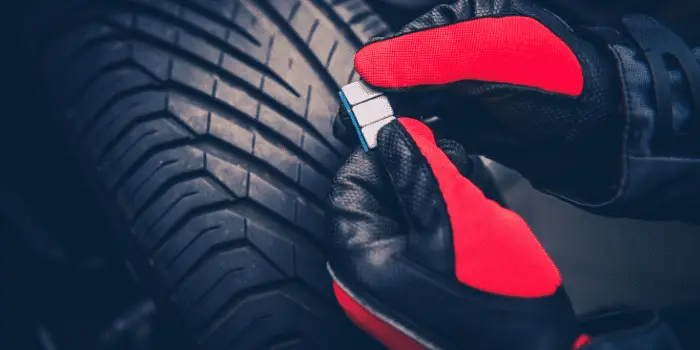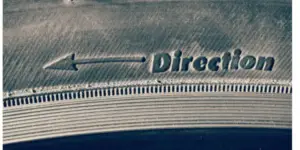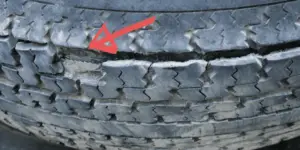Reputable tire shops will always balance new tires after fitting them. If your new tires have been balanced and are still vibrating, this points to other issues that aren’t related to the new tires.
You might have believed that your tires were bad or even been advised that they needed replacing, only to find this may not have been the case. You either still have a vibration, or a new one appears after your new tires are fitted.
If the old tires you’ve replaced were low on tread anyway, this isn’t such a big issue but replacing good tires and finding out they weren’t the cause of the vibration is annoying and costly.
Below we will look at what you can troubleshoot to fix the problem.
11 Causes of Tire Vibration After Balancing
Check The Remaining Older Tires
You can skip this section and move on to the brake section below if all four tires were replaced.
I recommend you check the other remaining tires before looking elsewhere.
Overinflated Tires
A badly overinflated tire will not have as much tread surface in contact with the road as it should. This can often give the feeling of the car floating and vibrating slightly along the road rather than gripping.
This is often because if one tire on the axle is overinflated, the pressure imbalance between the two can cause a vibration on that axle.
This is more commonly found on tires on the front axle, where the vibration can make its way to the steering wheel.
Aggressive Tire Tread
A bit of a long shot, but have you changed the manufacturer and type of tires fitted.?
Off-road tires and all-terrain tires have larger and deeper blocks of tread. If this type of tire is new to you, you might feel a slightly less comfortable and smooth ride than you did with summer or all-purpose tires.

This is a normal trade-off between extra tread and grip but a bit of vibration.
Flat Spotting
If you’ve left your car parked for an extended time, flat spotting may have occurred on one or all of your tires.
You won’t see this visually, but your tire will be slightly oval shaped, causing a vibration, especially at higher speeds.
You might be lucky, and the tire may get back into shape when it warms up, but often they never do and will need replacing.
If you have left your car for more than a month without moving it, you’ll need to go to a car shop and have your tires checked over for this, just in case.
Wheel Weight Fallen Off
A car shop will balance your new tires using weights. These small metal weights are stuck on your wheel rim with adhesive and are prone to falling off.

Conduct a visual inspection of your wheels to see if you can find any square areas that appear cleaner than the rest of the wheel. This could indicate a weight has recently fallen off that wheel and needs replacing.
Okay, so we have covered all tire causes and can look at other components that may be a fault and cause the vibrations you’re feeling.
Brake Issues and Vibration
Noises accompany most brake vibration issues. If no noise is associated with the vibration, then brakes are unlikely to be the issue, but not always.
Sometimes a brake caliper can become stuck and force the pad onto the rotor. This is extremely unlikely to happen on both wheels on the same axle.
Because it happens on one wheel on that axle, it can cause an imbalance in the speed the tires rotate. When the pads are forced to grip the rotor, there is usually a screeching noise accompanying any vibration.
One very good indication that you have an issue with your caliper sticking is the heat of the rotor.
Friction will cause the rotor to heat up, so if it is hot to the touch and you haven’t been aggressively breaking before checking, a stuck caliper could be the cause.
Why Brakes Feel Like They Are Skipping When You Brake
Brake pads sometimes become loose in their housing and can bang up and down slightly on the rotor when you brake. This causes vibration but only during braking.
Brake rotors can become warped from the factory or during their lifetime on your car. But again, you will experience vibration under braking and at no other time if the rotor is warped.
Wheel Alignment Issues
Wheel alignment and tire balancing are often confused. Wheel balancing alters and slightly corrects the position and angle of the wheel in relation to others on your car.
Contrary to what some believe, wheel alignment is not done as standard when you have your tires changed.
Wheel alignment is done independently of tire balancing, but if you still note vibration after having your tires balanced, a wheel alignment may be the solution.
The camber and toe alignment needs only to be out slightly for vibration to be felt. Another sign is that your car may wander slightly if you take your hand off the steering wheel.
Bent Rims
You might have bent a rim if you’ve hit a curb or been over a large pothole recently.
This can also be accompanied by the tire deflating quicker than the others as the seal around the bead is now less strong.
The damage isn’t visible to the human eye, but even a misalignment by a mm or two is enough to cause vibration.

Bent steel rims can often be repaired, but alloy wheels are often beyond repair, and you will have to buy a replacement instead.
Tire shops aren’t always the best place to enquire about repair, especially alloys. To have any chance of repairing an alloy, you need to go to an alloy wheel specialist to see if it can be salvaged.
Often the cost of repair can exceed the cost of a new alloy.
If the alloy can’t be salvaged and is an older style, you may have difficulty finding a replacement to match your other three alloys.
Often online auctions like eBay will have used alloys available, but if not, you are left in a situation where you might have to have one alloy fitted that doesn’t match the other three you already have.
Depending on how important having everything perfect on your car is, too, you will dictate whether you buy a brand new set of all four alloys or make do with one odd one.
Wheel Bearing
Usually accompanied by a grinding noise as the tire rotates, a wheel bearing can cause the car to vibrate, although this is rare.
Many visitors also read this article: Do Wheel Bearings Affect Brakes? [ANSWERED]
If the wheel bearing on a front axle is bad, you may feel the vibration coming up through the steering wheel.
Motor Mounts
Your car’s engine is the heaviest component and needs to be secured. Motor mounts do this.
Most cars have 3 or 4 large bolts that ensure that when you turn your car, the engine doesn’t move when you carry out this maneuver.
Even the slightest movement can cause the car’s balance to become uneven, which can cause vibration.
Suspension and Steering
A good car shop will check the condition of the suspension components that lead into the wheels when you’ve had your tires changed.
This is especially true of the tie rod ends, the ball joints, and the CV Joints.
CV Joints have rubber boots that, when ruptured, can leak oil and cause dirt to get in. When CV Joints fail, they become loose, and this can cause vibration.
Many visitors also read this article: Why Does My Steering Wheel Shake When I Brake? – Is It Bad?
Bad ball joints can cause a clunking or vibrating sensation, especially when turning the steering wheel.
Tight rod ends connect the front wheels to the steering wheel. A good technician may notice that they have failed when changing your tires.
In Conclusion
Mistakes can be made, so take your car back to the tire shop and ask them to check the tire balancing again. The vibration is probably related to another tire or suspension problem if that tire is good.





![How Long Do New Tires Take To Put On? [ANSWERED] Torque-wrench-tire](https://carzaza.com/wp-content/uploads/2023/12/Torque-wrench-tire-300x150.png)






